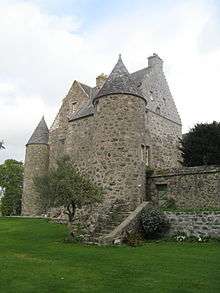Barra Castle

Barra Castle is an unusual L-plan tower house, dating from the early 16th century, about two miles south of Oldmeldrum, above the Lochter Burn, in the parish of Bourtie,[1] Aberdeenshire, Scotland.[2] It occupies the site of the battle in which Robert Bruce defeated John Comyn, Earl of Buchan.[2]
History
A castle on this site was, from the mid-13th century, the seat of the King family.[1]
An earlier castle associated with the hereditary Forester and Coroner of the Garioch, a Blackhall,[3] may be incorporated in the main block and south-eastern wing, but the present castle owes its form mainly to George Seton, chancellor of the University of Aberdeen, Tutor and Vicar of Meldrum[3] who was granted the estate in 1598.[2] A charter of 1599 to George Seton, tutor of Meldrum, mentions the erection of the lands of Barra as a free barony, while a charter of 1615, ordains that the 'fortalice of Barra' is to be the chief seat of the barony.[3]
James Reid, an Aberdeen advocate,[3] was in possession of the estate by 1630, and the Reid family retained it until 1754. Dame Margaret Abercrombie, the wife of John Reid (who was made a baronet in 1703), refitted parts of the house; she may be responsible for the fireplace in the Great Hall.[2]
The purchaser in 1754 was John Ramsay of Melrose, a merchant trading in Russia,[3] who added the north wing, and his descendants still own it; a Ramsay heiress married Andrew Irvine,[3] one of the Irvines of Drum, early in the 20th century.[2] John Ramsay preferred his estate at Straloch, and after his death in 1787 the property came to be used as a farmhouse. It was restored as a dower house, to plans by George Bennet Mitchell, in the first decade of the twentieth century.[2]
Structure
The plan of the castle is an unusual variation on the L-plan, with the main block of the castle lying north to south. There is a circular tower at the south-west. A D-plan tower at the south-east contains the main stair and entrance. This tower, corbelled square at the top to give a watch-room, links to a large square wing. At its north-west angle this wing has a second circular tower.[2] The castle’s entrance is in the main re-entrant angle.[2] The towers have conical roofs.[3]
Running eastward from the north end of the main block there is an addition, dating from the 18th century. A wall to the east, which contains the entrance, forms the fourth side of a square court.[2]
The buildings around the courtyard are three storeys high, built of pinned boulder rubble. The main gables are crow stepped. The drawing room, which is panelled, has a large chimneypiece, with a later one inserted in it. The first floor bedroom in the South East wing has panelling dating from early to mid 18th century. There is a panelled sitting room in the North wing.[4]
It is a category A listed building[4] and is constructed on the site of Robert the Bruce's successful battle against John Comyn, Earl of Buchan in 1308.[5]
The Hunterian Museum in Glasgow has a hammerstone from Barra Castle.[3]
Paintings
There are two paintings of the interior of the castle by James Cassie in the Aberdeen Art Gallery:
References
| Wikimedia Commons has media related to Barra Castle. |
- 1 2 "Parish of Bourtie". Gazetteer for Scotland. Retrieved 2014-02-12.
- 1 2 3 4 5 6 7 8 9 Lindsay, Maurice (1986) The Castles of Scotland. Constable. ISBN 0-09-473430-5 p77
- 1 2 3 4 5 6 7 8 "Barra Castle". Canmore. Retrieved 2014-02-12.
- 1 2 "Barra Castle". British Listed Buildings. Retrieved 2014-02-11.
- ↑ MacGibbon, David; Ross, Thomas (1887), The castellated and domestic architecture of Scotland from the twelfth to the eighteenth century, D. Douglas, p. 399
Coordinates: 57°11′31″N 2°12′17″W / 57.1919°N 2.2048°W